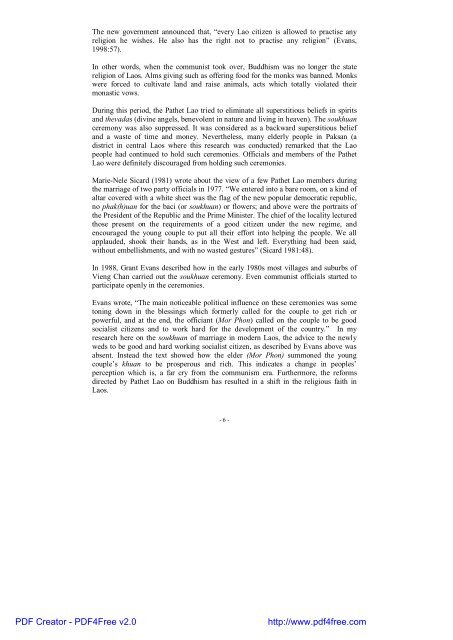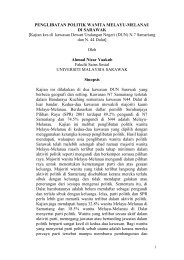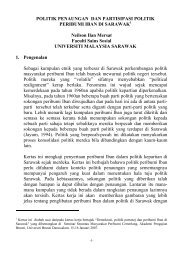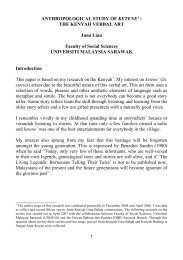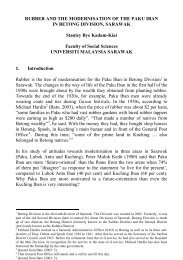OF SOUKHUAN AND LAOS Elena Gregoria Chai Chin Fern Faculty ...
OF SOUKHUAN AND LAOS Elena Gregoria Chai Chin Fern Faculty ...
OF SOUKHUAN AND LAOS Elena Gregoria Chai Chin Fern Faculty ...
You also want an ePaper? Increase the reach of your titles
YUMPU automatically turns print PDFs into web optimized ePapers that Google loves.
The new government announced that, “every Lao citizen is allowed to practise any<br />
religion he wishes. He also has the right not to practise any religion” (Evans,<br />
1998:57).<br />
In other words, when the communist took over, Buddhism was no longer the state<br />
religion of Laos. Alms giving such as offering food for the monks was banned. Monks<br />
were forced to cultivate land and raise animals, acts which totally violated their<br />
monastic vows.<br />
During this period, the Pathet Lao tried to eliminate all superstitious beliefs in spirits<br />
and thevadas (divine angels, benevolent in nature and living in heaven). The soukhuan<br />
ceremony was also suppressed. It was considered as a backward superstitious belief<br />
and a waste of time and money. Nevertheless, many elderly people in Paksan (a<br />
district in central Laos where this research was conducted) remarked that the Lao<br />
people had continued to hold such ceremonies. Officials and members of the Pathet<br />
Lao were definitely discouraged from holding such ceremonies.<br />
Marie-Nele Sicard (1981) wrote about the view of a few Pathet Lao members during<br />
the marriage of two party officials in 1977. “We entered into a bare room, on a kind of<br />
altar covered with a white sheet was the flag of the new popular democratic republic,<br />
no phak(h)uan for the baci (or soukhuan) or flowers; and above were the portraits of<br />
the President of the Republic and the Prime Minister. The chief of the locality lectured<br />
those present on the requirements of a good citizen under the new regime, and<br />
encouraged the young couple to put all their effort into helping the people. We all<br />
applauded, shook their hands, as in the West and left. Everything had been said,<br />
without embellishments, and with no wasted gestures” (Sicard 1981:48).<br />
In 1988, Grant Evans described how in the early 1980s most villages and suburbs of<br />
Vieng Chan carried out the soukhuan ceremony. Even communist officials started to<br />
participate openly in the ceremonies.<br />
Evans wrote, “The main noticeable political influence on these ceremonies was some<br />
toning down in the blessings which formerly called for the couple to get rich or<br />
powerful, and at the end, the officiant (Mor Phon) called on the couple to be good<br />
socialist citizens and to work hard for the development of the country.” In my<br />
research here on the soukhuan of marriage in modern Laos, the advice to the newly<br />
weds to be good and hard working socialist citizen, as described by Evans above was<br />
absent. Instead the text showed how the elder (Mor Phon) summoned the young<br />
couple’s khuan to be prosperous and rich. This indicates a change in peoples’<br />
perception which is, a far cry from the communism era. Furthermore, the reforms<br />
directed by Pathet Lao on Buddhism has resulted in a shift in the religious faith in<br />
Laos.<br />
- 6 -<br />
PDF Creator - PDF4Free v2.0<br />
http://www.pdf4free.com


